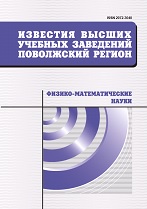|
|
University proceedings. Volga region. Physical and mathematical sciences, 2013, Issue 3, Pages 58–69
(Mi ivpnz393)
|
 |
|
 |
Mathematics
The integration algorithm using the $L$-stable and explicit methods
E. A. Novikov
Institute of Computational Modeling of Siberian Branch of Russian Academy of Scien, Krasnoyarsk
Abstract:
Background. When modeling the kinetics of chemical reactions, calculating electronic circuits and electrical networks and other critical applications there is a need to solve the Cauchy problem for stiff systems of ordinary differential equations. Materials and methods. To solve these problems L-stable numerical schemes are applied. In such methods basic computing costs fall on the decomposition of the Jacobi matrix due to high dimensionality of the differential equations system. Cost reduction is achieved by freezing the Jacobian matrix, i.e. using the same matrix in several integration steps. Additional cost savings are achieved by applying heterogeneous integration algorithms. The structure of such algorithms includes explicit and L-stable methods. These algorithms automatically recognize whether the problem is stiff or not. An efficient numerical scheme is chosen at each step according to a criterion of stability. The heterogeneous integration algorithm based on the L-stable and the explicit two-stage methods is constructed. The inequality for stability control of the second order Runge-Kutta scheme is constructed. The numerical formula of the first order with the extended up to 8 interval of stability based on stages of this method has been proposed. Based on the L-stable (2,2)-scheme and numerical formulas of the first and second orders of accuracy Runge – Kutta method, the algorithm of variable structure in which the most efficient method is chosen at each step according to the criterion of stability has been constructed. The Jacobi matrix freezing is allowed while using the L-stable method. Besides, the matrix can be calculated both analytically and numerically. The algorithm is designed for the solution of both stiff and non-stiff problems. Results. Numerical results confirm the efficiency of the algorithm.
Keywords:
stiff problems, (m, k)-schemes, the Runge – Kutta method, the accuracy and stability control.
Citation:
E. A. Novikov, “The integration algorithm using the $L$-stable and explicit methods”, University proceedings. Volga region. Physical and mathematical sciences, 2013, no. 3, 58–69
Linking options:
https://www.mathnet.ru/eng/ivpnz393 https://www.mathnet.ru/eng/ivpnz/y2013/i3/p58
|

| Statistics & downloads: |
| Abstract page: | 35 | | Full-text PDF : | 10 | | References: | 15 |
|




 Contact us:
Contact us: Terms of Use
Terms of Use
 Registration to the website
Registration to the website Logotypes
Logotypes








 Citation in format
Citation in format 